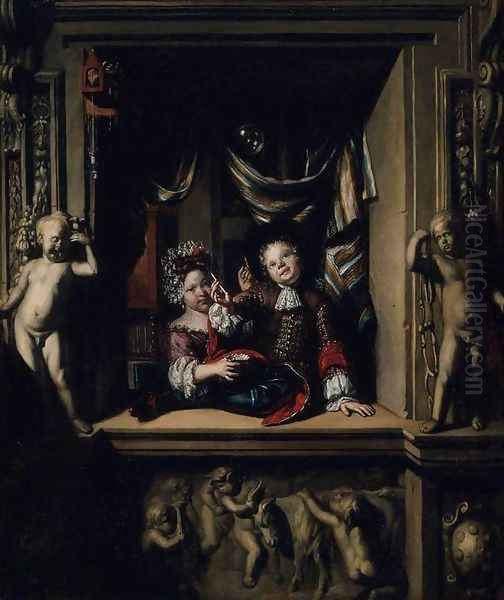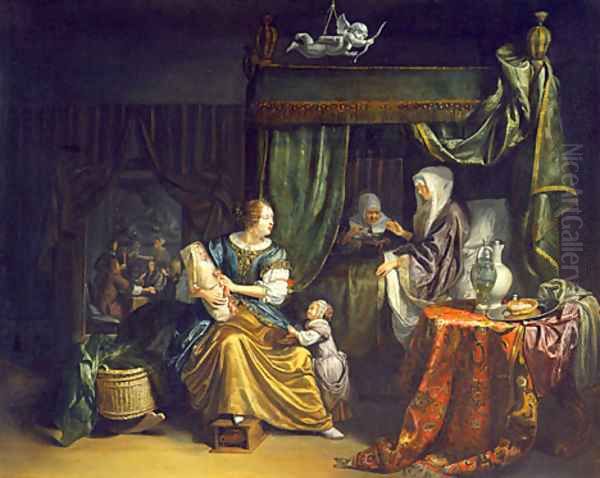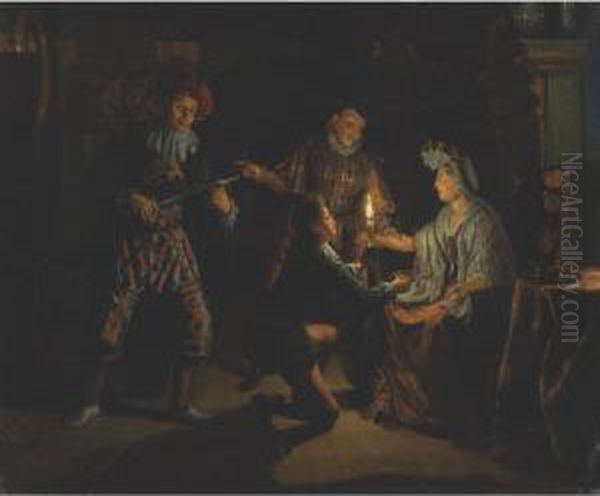Matthijs Naiveu, also known as Mathys Neveu or Mattheus Naiveu, stands as a notable, if sometimes overlooked, figure among the painters of the Dutch Golden Age. Active during a period of immense artistic flourishing, Naiveu carved out a niche for himself with his lively genre scenes, capturing the everyday activities, social customs, and intimate moments of seventeenth and early eighteenth-century Dutch society. His work provides a valuable window into the era, rendered with a distinct approach to color, composition, and narrative.
Early Life and Artistic Formation in Leiden
Matthijs Naiveu was born in Leiden on April 16, 1647. Leiden, at this time, was a prominent center for art and learning, home to a university and a thriving community of painters. It was particularly known for the "Leiden fijnschilders" (fine painters), a group renowned for their meticulously detailed and highly polished technique. This artistic environment undoubtedly shaped Naiveu's early sensibilities.
His formal artistic training began under Abraham Toornvliet (c. 1620–1692), a respected glass painter and draughtsman. Training with a glass painter might have instilled in Naiveu an appreciation for the effects of light and the richness of color, elements that would become characteristic of his later work. More significantly, Naiveu became a pupil of Gerrit Dou (1613–1675), one of the most celebrated of the Leiden fijnschilders and himself a former student of Rembrandt van Rijn.
Dou's influence on his pupils was profound. He emphasized minute detail, smooth brushwork that concealed individual strokes, and the depiction of textures with almost photographic accuracy. His subjects often included domestic interiors, scholars in their studies, and market scenes, all rendered on a small scale with jewel-like precision. While Naiveu absorbed these lessons, his own artistic temperament would eventually lead him to develop a style that, while detailed, often possessed a broader, more animated quality than the highly refined works of Dou or Dou's other famous pupil, Frans van Mieris the Elder (1635–1681). Other contemporaries in Leiden who shared this meticulous approach included Gabriël Metsu (1629–1667) and Pieter de Hooch (1629–1684) in his earlier Leiden period, before he moved to Amsterdam and developed a different focus.
Relocation to Amsterdam and Professional Life

Around 1671, Naiveu moved from Leiden to Amsterdam, the bustling commercial and cultural heart of the Dutch Republic. This move was significant, as Amsterdam offered a larger market for artists and a different social milieu. It was in Amsterdam that Naiveu would spend the majority of his productive career. He officially became a citizen (poorter) of Amsterdam in 1678, a necessary step for many professional tradesmen and artists to establish themselves fully.
Interestingly, Naiveu did not solely rely on painting for his livelihood. He also held the position of "Hop-inspecteur" (Hop Inspector) for the brewers of Amsterdam. This role, overseeing the quality of hops used in beer production, was a respectable municipal appointment and would have provided a steady income. It also suggests a practical, engaged side to his personality, and perhaps offered him unique insights into the city's commercial life and its taverns, which sometimes featured in his paintings. This dual career was not entirely uncommon; Jan Steen (c. 1626–1679), another prominent genre painter, was also an innkeeper.
Naiveu married Geertruyt Ruyters in 1665, and they had children, with records indicating he became a father in 1666. His family life and the domestic sphere became recurrent themes in his art, particularly in depictions of childbirth and family gatherings. His artistic activity is documented from around 1668, and he remained productive until at least 1721. Matthijs Naiveu passed away in Amsterdam on June 4, 1726, at the age of 79, leaving behind a substantial body of work.
Artistic Style, Themes, and Influences
Matthijs Naiveu's art is firmly rooted in the genre painting tradition of the Dutch Golden Age, which focused on scenes of everyday life. His style can be broadly characterized as Baroque, with an emphasis on dynamic compositions, the interplay of light and shadow (chiaroscuro), and often, vibrant, even bold, coloration.
While he learned the meticulous techniques of the Leiden fijnschilders from Gerrit Dou, Naiveu's application of paint was often less polished and more robust than that of his master or peers like Frans van Mieris the Elder or Willem van Mieris (1662-1747). His figures can appear more animated and less idealized, contributing to a sense of immediacy and liveliness in his scenes. Some critics have noted his palette as being particularly bright, occasionally described as "gaudy" or "coarse" by commentators accustomed to the more subdued tones of other Dutch masters. However, this vibrancy also lends his work a distinctive energy.
Naiveu's thematic range was diverse. He depicted:
Domestic Interiors: Scenes of family life, such as visits to newborns, children playing, and household activities. These works often convey warmth and intimacy.

Tavern and Inn Scenes: Reflecting perhaps his work as a hop inspector, he painted lively gatherings in public houses, capturing the conviviality and sometimes boisterous nature of these establishments. These can be compared to the works of Adriaen Brouwer (1605/6-1638) or Adriaen van Ostade (1610–1685), though Naiveu's scenes are generally less rustic.
Street Scenes and Markets: Depictions of urban life, including craftsmen at work, street vendors, and public entertainments.
Allegorical and Religious Scenes: While primarily a genre painter, Naiveu also produced works with allegorical or religious significance, most notably his series on the "Seven Works of Mercy."
Portraits: Less common, but he did undertake portraiture.
A notable characteristic of Naiveu's later work is an increasing interest in theatricality and entertainment. He depicted street performers, commedia dell'arte figures, and scenes with a heightened sense of drama or amusement. This aligns with a broader trend in late 17th-century Dutch art, where artists like Jan Steen often infused their genre scenes with a narrative, almost stage-like quality.
Comparisons can be drawn with several contemporaries. His detailed rendering of interiors and figures echoes the Leiden school, but his broader handling and more dynamic compositions sometimes bring to mind the work of artists like Richard Brakenburgh (1650–1702) or Cornelis Dusart (1660–1704), who also depicted lively peasant and town scenes. While distinct from the serene and light-filled interiors of Johannes Vermeer (1632–1675) or the psychologically penetrating portraits of Rembrandt (1606–1669), Naiveu shares with them a commitment to observing and rendering the world around him.
Representative Works
Several paintings stand out as representative of Matthijs Naiveu's oeuvre and highlight his artistic concerns:
"The Seven Works of Mercy" (series, c. 1670s): This series is often considered a high point in Naiveu's career. Each painting illustrates one of the traditional acts of Christian charity: feeding the hungry, giving drink to the thirsty, clothing the naked, sheltering the homeless, visiting the sick, visiting the imprisoned, and burying the dead. These works combine religious subject matter with detailed genre elements, showcasing Naiveu's ability to handle complex multi-figure compositions and convey narrative effectively. The settings are contemporary Dutch environments, making the biblical injunctions relevant to his audience.

"A Visit to the Lying-in Room" / "The Newborn Baby" (e.g., 1675, Rijksmuseum, Amsterdam): This was a popular theme in Dutch art, celebrating family and continuity. Naiveu painted several versions. These works typically depict a well-appointed interior where the new mother receives visitors. Naiveu excels in rendering the textures of fabrics, the details of the furnishings, and the interactions between the figures. The atmosphere is one of quiet joy and social ritual. Such scenes can be compared to similar depictions by artists like Gabriël Metsu or Godfried Schalcken (1643-1706), another pupil of Dou known for his candlelight scenes.
"Boy and Girl Blowing Bubbles" (c. 1700, private collection): This charming painting is an example of a "vanitas" theme, where the fleeting nature of soap bubbles symbolizes the transience of life and earthly pleasures. The children are engrossed in their play, rendered with Naiveu's characteristic attention to detail and bright colors. The composition is balanced, and the interplay of light and shadow adds depth. The theme of children blowing bubbles was also explored by artists like Frans Hals (c. 1582/83–1666) in a broader manner and by fijnschilders like Jacob van Loo (1614-1670) with more polished detail.
"A Visit to the Nursery" (c. 1700, Hallwyl Museum, Stockholm): Similar to the "lying-in room" scenes, this work focuses on the care and celebration of childhood. Naiveu captures the interactions between adults and children with a sense of warmth and observation. The detailed rendering of clothing, toys, and the domestic setting provides a rich glimpse into the material culture of the period.
"Street Shoemaker at Work" (c. 1710): This painting exemplifies Naiveu's interest in depicting everyday labor and street life. The shoemaker is shown engrossed in his craft, surrounded by the tools of his trade. Such scenes highlight the dignity of manual labor and offer a snapshot of urban economic activity. Quiringh van Brekelenkam (c. 1622–c. 1669), another Leiden artist, also specialized in scenes of craftsmen and domestic interiors.
"Tavern Scene" (various): Naiveu produced several paintings depicting the interiors of taverns or inns. These scenes are often filled with animated figures drinking, smoking, playing games, or conversing. They capture the social atmosphere of these public spaces, which were central to Dutch community life. His approach here can be contrasted with the more boisterous and sometimes moralizing peasant scenes of Jan Steen or the more refined gatherings depicted by artists like Dirck Hals (1591–1656).
Collaborations and Artistic Connections
While direct, documented collaborations in the sense of co-painting a single canvas are not prominent in Naiveu's known history, his artistic connections were manifold through his training and the close-knit nature of Dutch artistic circles.
His primary connection was, of course, with his teacher Gerrit Dou. As a student, he would have worked in close proximity to Dou and other pupils, absorbing techniques and stylistic approaches. The influence of Dou's meticulous style is undeniable, even if Naiveu later diverged.
He was also a contemporary of Frans van Mieris the Elder, another star pupil of Dou. While their styles differed in polish, they shared the Leiden fijnschilder heritage. It's plausible they knew each other and moved in similar artistic circles, especially during Naiveu's Leiden years.
The mention of Jacob Toorenvliet (1640–1719) in connection with Naiveu, possibly in activities like frame-making or other shared guild responsibilities, points to the practical, day-to-day interactions between artists. Jacob Toorenvliet, also from Leiden and a painter of genre scenes and portraits, had a style that sometimes shared Naiveu's liveliness.
Comparisons are often made between Naiveu's work and that of Jan Steen, particularly in their shared interest in lively, narrative genre scenes, sometimes with a theatrical or humorous bent. While Steen's figures are often more overtly expressive and his compositions more complex, both artists captured the vibrant social fabric of their time.
The broader artistic environment of Amsterdam would have exposed Naiveu to a wide range of influences. Artists like Nicolaes Maes (1634–1693), who started as a genre painter in Rembrandt's circle before turning to portraiture, or Emanuel de Witte (c. 1617–1692), known for his church interiors and market scenes, contributed to the rich artistic tapestry of the city. Even if not directly collaborating, artists were aware of each other's work through exhibitions, sales, and guild activities.
The mention of Rachel Ruysch (1664–1750), a renowned flower painter, and Nicolaas Verkolje (1673–1746), a painter of portraits and genre scenes, in the context of similar techniques or materials, suggests that art historians find common threads in the technical approaches of various Dutch artists of this period, even across different specializations. Carel Fabritius (1622–1654), a brilliant pupil of Rembrandt whose career was tragically cut short, was known for his innovative use of perspective and light; while his style was different, any comparison would highlight Naiveu's place within the broader spectrum of Dutch painting.
Historical Evaluation and Legacy
Matthijs Naiveu's reputation has evolved over time. During his lifetime, he achieved a degree of success, evidenced by his sustained production and his municipal appointment. However, he did not reach the same level of fame or command the same high prices as the leading Leiden fijnschilders like Dou or Frans van Mieris, or Amsterdam giants like Rembrandt or Vermeer.
In subsequent centuries, particularly the 19th century when Dutch Golden Age art was being rediscovered and re-evaluated, Naiveu was sometimes criticized for a perceived lack of refinement. His bolder colors and less polished brushwork were occasionally seen as "coarse" when compared to the delicate finish of the fijnschilders. This assessment, however, often overlooked the distinct strengths of his work: its vibrancy, its narrative clarity, and its engaging depiction of human activity.
Today, art historians appreciate Matthijs Naiveu for his contribution to the breadth of Dutch genre painting. His works are valued for their historical and sociological insights, offering vivid glimpses into the customs, attire, and daily life of the period. His paintings are held in numerous public collections, including the Rijksmuseum in Amsterdam, the Metropolitan Museum of Art in New York, the Louvre in Paris, and the Museum of Fine Arts in Boston, testifying to his recognized, if not premier, status.
His "Seven Works of Mercy" series, in particular, is acknowledged as a significant achievement, demonstrating his ability to handle complex compositions and convey moral themes with a human touch. His depictions of domestic life, especially those involving children and family celebrations, resonate with a timeless appeal.
Conclusion
Matthijs Naiveu was a skilled and productive painter who made a distinctive contribution to the rich tapestry of Dutch Golden Age art. Emerging from the meticulous tradition of the Leiden fijnschilders under the tutelage of Gerrit Dou and Abraham Toornvliet, he developed his own more robust and colorful style, well-suited to capturing the dynamism of everyday life in Leiden and, later, Amsterdam.
His diverse subject matter, from intimate domestic scenes like "A Visit to the Lying-in Room" to bustling street views like "Street Shoemaker at Work," and ambitious series such as "The Seven Works of Mercy," reveals an artist keenly observant of the world around him. While perhaps not possessing the sublime subtlety of a Vermeer or the profound psychological depth of a Rembrandt, Naiveu's paintings offer an engaging, animated, and invaluable record of his time. He remains an important figure for understanding the breadth and variety of genre painting in the Netherlands, a chronicler whose canvases continue to bring the Dutch Golden Age to life for contemporary audiences. His works stand as a testament to an artist who, while also engaged in civic duties as a hop inspector, dedicated much of his life to the art of painting, leaving a legacy that enriches our understanding of a remarkable period in art history.